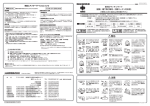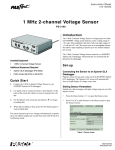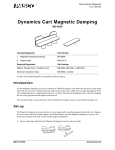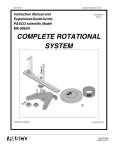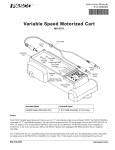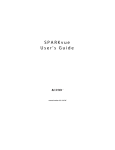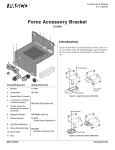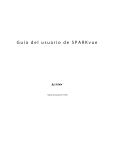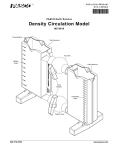Download PASCO Specialty & Mfg. PS-2129A User's Manual
Transcript
Instruction Manual 012-12232A *012-12232* Exercise Heart Rate Sensor PS-2129A Strap Hook Strap Adjuster Red LED Electrodes (not shown) Transmitter Sensor Transmitter Strap Connector Snaps Equipment Introduction Included Part Number Exercise Heart Rate Sensor PS-2129A Polar® WearLink® Set (M-XXL) PS-2524 Also Required PASCO Interface see catalog or web site Data Acquisition Software see catalog or web site Recommended Part Number PASPORT Extension Cable PS-2500 Accessory Part Number Polar® WearLink® strap (XS-S) PS-2519 ® The Exercise Heart Rate Sensor uses a transmitter mounted on a transmitter strap and a receiver inside the sensor to measure heart rates from 40 to 240 beats per minute. The sensor can measure the heart rate during exercise without a sensor cable getting in the way because the transmitter and the receiver communicate wirelessly. The transmitter snaps onto the transmitter strap and the strap wraps around your chest with the transmitter positioned over the cardiac muscle. The transmitter sends the electrical signals from your heart to the Exercise Heart Rate Sensor. The Exercise Heart Rate Sensor averages the heart rate in five second intervals. A small red light-emitting diode (LED) on the sensor blinks when a heart beat is detected. The transmitter comes with a replaceable type CR 2505 battery that has an estimated life of two years (assuming one hour of use per day). The transmitter strap (PS-2524) is designed to fit medium to extra-extra large. An accessory transmitter strap (PS-2519) available separately from PASCO fits small to extra small. Exercise Heart Rate Sensor Introduction Wearing the Transmitter Strap The electrode areas that are on the reverse side of the transmitter strap detect the signals from the cardiac muscle. 1. Wet the electrode areas under running water and make sure that they are well moistened. 2. Attach the transmitter to the connector snaps on the transmitter strap. Transmitter Electrode Areas Connector Snap Step 2. Attach the Transmitter 3. Step 1. Wet the Electrodes Adjust the strap length to fit snugly and comfortably around your chest just below the chest muscles. Strap Hook Loop Step 3. Adjust the Strap Length Logo is upright Transmitter Strap Options Option One: Transmitter in Place • Option One - Under a Shirt: Follow steps 1, 2, and 3 above. Put the strap around your chest and connect the strap hook to the loop in the other end of the strap. Make sure that the wet electrode areas are firmly against your skin and that the transmitter is in a central location and the Polar logo on the transmitter is upright (see Option One). • Option Two - Over a Shirt: To use the transmitter over the top of a T-shirt or tank top, follow steps 1, 2, and 3 above. Put the strap around your chest on top of the shirt and connect the strap hook to the loop. Then, wet the shirt beneath the electrode areas of the strap so that the shirt and the skin beneath the shirt are well moistened. • Option Three - Hold in Both Hands: Wet the electrode areas and connect the transmitter to the strap, but hold the strap with both hands so that the palm area of each hand touches the wet electrode areas. [NOTE: With this option, the data quality may vary.] Wet the shirt beneath the electrode areas. Option Two: Over a Shirt Operation • • 2 Connect the Exercise Heart Rate Sensor to your PASCO interface. (NOTE: You may want to connect the sensor to a PASPORT Extension Cable (PS-2500) before connecting it to the interface.) PS-2500 PASPORT Extension Cable Start the data acquisition software and begin collecting data. ® Model No. PS-2129A Tips for Using the Exercise Heart Rate Sensor Care and Maintenance Transmitter • Detach the transmitter from the strap after use and dry the transmitter with a soft, clean cloth. Never use alcohol, cleaning chemicals, or an abrasive material to clean the transmitter. • Keep the transmitter in a cool, dry place. Do not store it wet inside a bag made of non-breathing material, such as a sports bag. Do not expose the transmitter to direct sunlight for extended periods. Transmitter Strap • Detach the transmitter from the connector snaps on the strap and rinse the strap under running water after every use. • Wash the strap regularly in a washing machine at 40°C (104°F) at least after every fifth use. Use a washing pouch. Do not use detergent with bleach or fabric softener. Do not soak, spin-dry, iron, dry clean, or bleach the strap. [NOTE: Never put the transmitter in the washing machine or drier.] • Dry and store the strap and the transmitter separately. Wash the strap before long-term storage. Tips for Using the Exercise Heart Rate Sensor • Keep the sensor within one meter (about 3 feet) of the transmitter. • Keep the sensor in a vertical orientation relative to the transmitter strap. Avoid placing the sensor in a horizontal or tilted orientation. • Place the sensor on a non-conductive (non-metal) surface and away from electrical interference (e.g., computers and electrical devices). • Do not place the sensor or the transmitter strap on metal objects or the ground. 1 meter Transmitter Sensor and Interface Signal Loss and Electrical Interference • Erratic measurements or large reading fluctuations (e.g., drop to 0 beats per minute (bpm) or sudden increase to 240 bpm) usually indicate signal loss. • The most common causes of signal loss are strap movement, inadequate electrode contact, improper sensor orientation, or too large a distance between the transmitter and the sensor. • If signal loss occurs, re-wet the electrodes, check the electrode contact, and move the sensor closer to the transmitter. • Avoid computer monitors, magnets, power cords, television sets, or other appliances that emit electromagnetic radiation. REMINDER: The red LED on the sensor flashes when there is adequate signal reception. ® 3 Exercise Heart Rate Sensor T ip s f o r U s i n g t h e E x e r c i s e H e a r t R a t e S e n s o r Battery To change the battery, follow these steps. 1. Use a coin to open the battery cover by turning it counterclockwise (to OPEN). 2. Remove the old battery and insert the new battery (CR2025) inside the cover with the positive (+) side against the cover. 3. Make sure that the “O-ring” that seals the cover is seated in the sealing groove to ensure water resistance. 4. Use the coin to turn the cover clockwise to close. Coin CAUTION: The transmitter is water resistant but the Exercise Heart Rate Sensor is not. Immersing the sensor in liquid will damage the sensor. Therefore, it is not recommended for you to use the transmitter and sensor in water. Battery cover Transmitter Heart Rate Activity Suggestions • Connect the sensor to an interface and put on the transmitter and strap. Orient the sensor. • Sit in a chair. Start collecting data. Record your resting heart rate for 60 seconds. • Stand up. Run in place for three to five minutes and continue to collect data. • Stop running but continue to collect data for another five minutes. After five minutes, stop collecting data. • Use the data acquisition software to graph your data. Compare your resting heart rate to your heart rate during exercise and during the five minute recovery time after exercise. Table 1: Recommended Exercise Heart Rate Levels Age (yrs.) Max. Heart Rate (bpm)* Min. Training Threshold** Max. Training Threshold*** 15 205 123 185 20 200 120 180 25 195 117 176 30 190 114 171 *Maximum estimated heart rate is 220 – age (years). **Minimum training threshold is equal to 60% of the maximum heart rate. ***Maximum training threshold is equal to 90% of the maximum heart rate. Ranges are based on the American College of Sports Medicine recommendations for healthy individuals. Ranges will vary. CAUTION: The Exercise Heart Rate Sensor is NOT a diagnostic tool. 4 ® Model No. PS-2129A Tips for Using the Exercise Heart Rate Sensor Experiment Suggestions • Heart rate, respiration, and skin temperature during exercise. • Effect on exercise heart rate for various forms of exercise (e.g., aerobic vs. anaerobic). • Exercise recovery rates for individuals with different fitness. • Exercise heart rate in healthy and diseased populations. Sample Data: Heart Rate Changes During and After Fourteen Minutes of Exercise at a Constant Intensity and Workload Sensor Specifications Heart rate range 40 to 240 beats per minute Transmitter range Approximately one meter Resolution One beat per minute Accuracy One beat per minute Default sample rate One sample per five seconds Maximum sample rate Five samples per second Averaging interval Five seconds ® 5 Exercise Heart Rate Sensor T e c h n ic a l S u p p o r t Technical Support Limited Warranty PASCO scientific warrants the product to be free from defects in materials and workmanship for a period of one year from the date of shipment to the customer. PASCO will repair or replace, at its option, any part of the product, which is deemed to be defective in material or workmanship. The warranty does not cover damage to the product caused by abuse or improper use. Determination of whether a product failure is the result of a manufacturing defect or improper use by the customer shall be made solely by PASCO scientific. Responsibility for the return of equipment for warranty repair belongs to the customer. Equipment must be properly packed to prevent damage and shipped postage or freight prepaid. (Damaged caused by improper packing of the equipment for return shipment will not be covered by the warranty.) Shipping costs for returning the equipment after repair will be paid by PASCO scientific. Before you call PASCO technical support, have the apparatus and this user's guide available. Please note the following: • Software version; • Product name and model number; • Approximate age of the product; • Detailed description of the problem/sequence of events required to duplicate the problem. For assistance with any PASCO product, contact PASCO at: Address: PASCO scientific 10101 Foothills Blvd. Roseville, CA 95747-7100 Phone: 916-786-3800 (worldwide) 800-772-8700 (U.S) Fax: (916) 786-7565 Web: www.pasco.com Email: [email protected] Copyright The PASCO scientific 012-12232A Exercise Heart Rate Sensor Instruction Manual is copyrighted with all rights reserved. Permission is granted to non-profit educational institutions for reproduction of any part of this manual, providing the reproductions are used only in their laboratories and classrooms, and are not sold for profit. Reproduction under any other circumstances, without the written consent of PASCO scientific, is prohibited. Trademarks PASCO, PASCO scientific, DataStudio, ImagiProbe, PASPORT, and ScienceWorkshop are trademarks or registered trademarks of PASCO scientific, in the United States and/or in other countries. All other brands, products, or service names are or may be trademarks or service marks of, and are used to identify, products or services of, their respective owners. For more information visit www.pasco.com/legal. Product End of Life Disposal Instructions: This electronic product is subject to disposal and recycling regulations that vary by country and region. It is your responsibility to recycle your electronic equipment per your local environmental laws and regulations to ensure that it will be recycled in a manner that protects human health and the environment. To find out where you can drop off your waste equipment for recycling, please contact your local waste recycle/disposal service, or the place where you purchased the product. The European Union WEEE (Waste Electronic and Electrical Equipment).symbol (to the right) and on the product or its packaging indicates that this product must not be disposed of in a standard waste container. Battery Disposal Instructions: Battery Disposal - Batteries contain chemicals that, if released, may affect the environment and human health. Batteries should be collected separately for recycling, and recycled at a hazardous material disposal location adhering to your country and local government regulations. To find out where you can drop off your waste battery for recycling, please contact your local waste disposal service or the product representative. The battery or batteries included in this product or purchased in the European Union (if batteries not included) are marked with the European Union symbol for waste batteries (above) to indicate the need for the separate collection and recycling. For small batteries, the symbol is printed on the packaging. 6 ®







